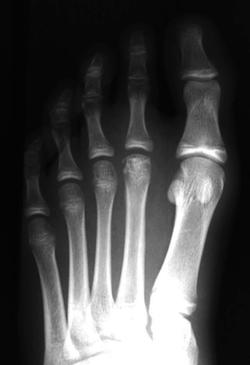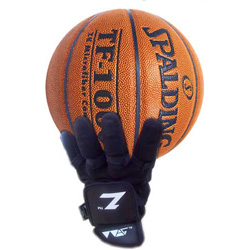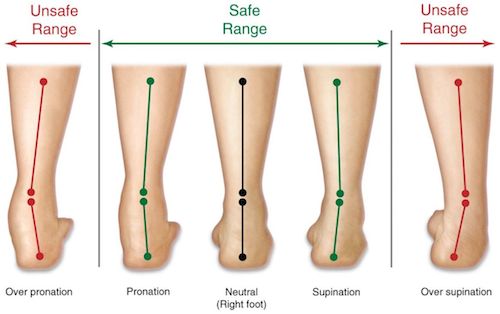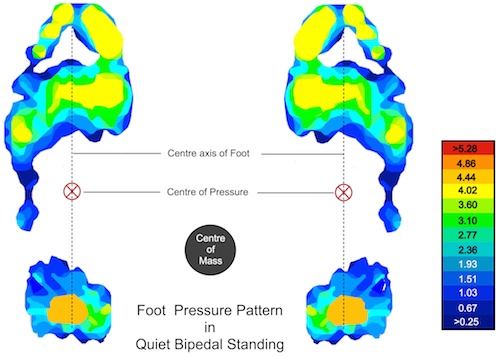
26 Bones!
Ever wonder why so many people have knee and hip pain when the foot is obviously more fragile? Shoes can protect your feet, but they often cause more problems up the chain.
Your feet form an intricate foundation for a complicated system – there’s a lot that can go wrong.
The soles of your feet have hundreds of nerve endings and joint motion receptors that send constant feedback to your brain about the environment and body position.
Ignoring your feet sets you up for pain and fatigue throughout your body, and an increased likelihood of injury when you push your limits.
Sounds bad, right? So let’s get this sorted out, and make sure you’re armed with the info necessary for maintaining healthy feet.
The Science of Barefoot Standing
Each of your feet has 26 bones, 3 different arches, and a variety of specialized muscles to control your ankle, foot, and toe movements.
Research shows that during barefoot standing, 60% of weight is supported by the heels, 28% by the forefoot, and 8% by the mid-foot. For you visual learners, that looks like this:
All that complicated circuitry we discussed above works together to keep you standing upright (for you physicists, your body is an unstable inverted pendulum). Fortunately, you don’t need a fancy degree to understand why barefoot is better. Let’s look at a simple metaphor to clear it up.How Your Feet and Brain are Like Cruise Control in a Car
If you set your car’s cruise control to 70 mph, your car stays at roughly 70 mph. We’ve all done it, but it’s actually a cool technology. Once you set your desired speed, your car constantly checks its actual speed against your desired speed. If the current speed is too high, it slows you down; too low, it speeds you up. This is a “control loop” that takes inputs of desired speed and current speed, and performs outputs of throttle position motor movements.
Your feet and brain together also form a control loop. Your brain has a “desired balance” input, and can tell (from sensors throughout your body) what your “current balance” actually is. Your brain constantly compares your desired and current balance states, and enacts changes through your motors (muscles) to achieve/maintain the desired balance condition. Very complicated stuff that occurs multiple times per second.
How Shoes Disturb Your Brain’s Balance Control
Shoes hurt this system because they limit the motion the joints in your feet experience, atrophy your muscles, and reduce the quality of the sensory input information that your feet return to your brain.
Feet confined by shoes are bound to virtually the same surface all day long. Your foot is always in contact with the same contoured surface of the shoe. This flattens the signal your brain receives about the current state of your foot activity.
Putting shoes on your feet obscures your brain’s ability to determine how well you’re balancing, and whether its commanded changes in muscle activity are achieving the desired goal. This will cause your muscles to over- or under-react when an adjustment to your balance is needed, and it actually causes your brain to work harder.
If you’re wearing shoes right now, try to balance on one foot with your eyes closed. Quick – what was the phone number of your first best friend? Now say it backwards. Now try again barefoot.
When you wear shoes, your brain has to solve some complicated motion equations on the fly, because the sensors in your feet aren’t reporting back effectively. Imagine if you wore thick leather gloves your whole life. Could you even hope to shoot a basketball accurately?
What This Actually Means for Your Health and Happiness

Walking with shoes is like playing basketball with gloves.
With the control loop disrupted, your brain is bound to take shortcuts and send the wrong signals to your muscles. This increases the chances of unnatural tissue loading. Problems like locking your knees, standing asymmetrically, or putting too much weight on your heels.
It also blunts what should be important overuse signals. Sure, you might be able to run further in a pair of cushy athletic shoes. But is running unnaturally far really a good idea?
When you’re wearing shoes, your brain will likely keep at least one muscle group activated too long – throwing off the symmetry between opposing muscle groups.
That means increased likelihood of sprains, strains, and tears. And don’t even get us started on the damage done to our elderly population. More bare footing about could have prevented a lot of broken hips.
As touched on earlier, beyond the physical effects, disrupting one of your brain’s many control loops may have mental effects as well. In small experiments we’ve run in our office, standers performed as much as 10-15% better on cognitive tests when barefoot than when wearing hard-soled shoes. And as we’ve covered before, increasing mental performance just 10% can have huge positive effects.
Restore Healthy Brain-Foot Connection by Standing Barefoot
Just take off your shoes! Your feet will be able to touch and feel the surface of the floor, the carpet, and your anti-fatigue mat. Movements such as toe curling, arch flexing, and foot pivoting will start happening naturally and spontaneously when your feet are freed from their evil shoe prisons. And we know how important to your health a little extra movement is.
If you work in an uptight office – grab a pair of office-appropriate slip-ons (or for ladies here). You’ll be able to pop your shoes on at a moment’s notice to avoid any embarrassment. This will allow you to easily slip off your shoes at your desk, and slip them back on anytime you leave your workstation.
Take it easy and plan a gradual transition if this is new for you. Remember what we said about muscle atrophy. Pay attention to the posture of your feet and use your quads and rear end to keep your feet from overpronating until you can restore the natural musculature and instincts of your feet. The Achilles tendon on the back of your heel should be vertical when you stand. No slouching!

Keep your achilles tendon vertical!
[image credit]
Have you tried ditching your shoes and going barefoot? How did it work for you? Let us know in the comments!







You should really check out Vivobarefoot shoes. They make an awesome range of barefoot shoes that are really thin, nice and wide and super flexible.
Be warned, I started wearing them last fall and can’t wear anything else!
Thanks for sharing Rachel. The Vivobarefoot shoe line looks awesome. We’ll have a barefoot shoe post up pretty soon, and you guys will be heavily featured.
For the readers, this model looks like a great choice for men, this one for women. If you’re looking for something more office appropriate, check out these ones for the ladies and gentlemen.
I like your office wear so much that I swapped out the Sanuks in this post for Vivos.
Keep up the good work!
Love the sound of those shoes, any distributor in Townsville?
Looks like there’s an athlete’s foot right near you that stocks them: http://www.theathletesfoot.com.au/shoe-brands/vivo
You may want to look at xeroshoes.com as well… Xeros are even closer to barefoot than Vivos. Plus, Xero Shoes are much less expensive, and have a 5,000 mile warranty.
Go check out Xero’s shoes if you’re looking for a very minimal sandal shoe. They’re awesome!
I strongly agree with you Steven, I have to pairs of Xero sandals and 2 pairs of vivobarefoot which I used in the winter time. I started my barefoot adventure 15 months ago, and so far I can say that after wearing vivos during the winter I started getting aches and pains in my ankle and knee. (which were problematic before going barefoot) My cure: switch to Xero sandals and barefoot hiking which solves all aches…:) Btw I really like the article, after being barefoot for this short time standing barefoot does not make me tired at all.
Vivobarefoot. Wear them all the time as does my podiatrist wife. Difficult to get in Australia unfortunately.
My wife and I go to http://www.solemechanics.com.au – based out of Australia. Great bunch of guys and girls to deal with and have a huge range!
This was a great read. As a man whom has fully transitioned into barefoot/minimalist style shoes for 3+ years now, I have a few more recommendations for men looking for shoes to wear at work and for dressing up. In addition to the aforementioned Vivobarefoot line of shoes, here are a few more options:
For business casual wear, both men & women can check out Lems Shoes (www.lemsshoes.com).
Business casual/dressy wear, men can check out TUNEfootwear (www.tunefootwear.com) & Altum Minimalist Footwear (www.altumco.com)
For real dressy/close to formal, men can check out the Primal Professional (www.theprimalprofessional.com)
hope this information helps!
I stopped wearing shoes,except in winter, 3 years ago and my back pain is almost completely gone (not completely because I still have a degenerated disc pinching my nerve). but I work somewhere where I can get away with being barefoot. when it’s hot and I have to walk on hot bricks or pavement, I wear xero shoes. in the winter I have a pair of Adidas track shoes that barely have a sole. I recommend this to everyone.
There is a huge difference between barefoot and minimalist footwear. Even wearing socks is not the same as barefoot. While minimalist footwear is indeed a step in the right direction, strive for BAREfoot. There is definitely a need for a transitional period, so don’t rush the process.
i came from over 23 yrs and 750,000 miles of bicycle road racing wearing carbon fiber and plastic soled rigid and binding shoes. 7 yrs ago I had a Forest Gump moment and realized I’d had enough of being on a bike. I transitioned to ultra running. In shoes I found what you said to be absolutely true. I got tired of being injured and hobbling home and took to the Internet to find solutions. That led me to Barefoot Running. I’ve since logged over 60,000 miles mostly bare with the balance in running sandals that allow my feet to behave like feet. It took thousands of miles to restore the health in my feet but it the best investment I have made other than also rediscovering Fruitar Fueling.
[…] be amazed by the physical and mental benefits. And you’ll be honoring your ancestors and […]
i have a pair of xero sandals which are awsome and very affordable, but winters where I live cam get pretty cold. I have found the converse slims a fantastic minimalist shoe! I found them online for $35 a pair and took out the insole and cardboard and I can role them up just like the xero sandal, the toe box is wide enough for plenty of spreading of my toes and the rubber sole in as thin as the xero sandal. Because they are cotton I just throw them in the wash when needed. I have been so happy because finding an autumn, winter shoe was looking pricier than I wanted! Another good option that I used but wore out really fast was the Patagonia advocate.
Great article – so succinct, given so many complex concepts. Thank you!
I love walking through the woods. Usually I wear shoes (because the beginning path has some broken glass–damn tourists!). I went barefoot once and it was a whole new experience. Usually I stroll through and admire all the trees, only looking at the ground occasionally. But when I was barefoot, I closely examined the ground the whole time. It added new sensations to my hike. I felt the earth with my feet. I experienced uniquely shaped rocks, the patterns of tree roots. I saw insects and interesting looking plants. I felt the happiness and relief of cool moss after walking on sharp pebbles. It was beautiful.
Awesome! Your line “It added new sensations to my hike” really resonated with me.
I totally remember when I started taking walks around the neighborhood barefoot – I had a strong desire to walk on different stuff. I’d be up on little retaining walls or balancing on tree roots. It made boring little walks much more exciting.
Thanks for the reminder, great comment.
I have been doing a lot of barefooting over the last three years. I do however wear shoes to work; usually Xero shoes, Vibram Five Fingers, Vivobarefoot or Lems. I slowly transitioned to barefoot; it takes a lot of time to develope our natural feet. I love feeling the different textures under my feet (sometimes it is a bit painful on certain surfaces. It makes me more aware and more present in the moment, because if I am not I might step on an pointy pebble or acorn that won’t feel too good. It’s tough in some places because shoes are a social requirement. I have to push myself sometimes to go in restaurants and some stores. The more people that do it the more acceptable it will become. The Society for Barefoot Living really helped me step out of my shoes. They have a Facebook site and a website: http://www.barefooters.org
Enjoy the adventure and self discovery that barefooting offers!!!
Great article. Would have been better if they also showed the silhouette of a healthy foot–not one mangled from narrow toeboxes. Those toes make me cringe in pain for the subject.
It seems that tightly pinched in toes like that would totally change the weight distribution, which is the point of that illustration. They should do another with undamaged feet that show how different weight distribution is with feet that operate correctly.
Hi. This is such a very useful artical for me.but actualy I have quistion about the pronation of foot. Those who have flatfoot suffer this pronation .so how they can solve this problem.
Flat feet have been known to raise up with walking barefoot often. Supporting an arch only makes it weaker.
I often go around at home in bare feet, not at work as I’m in a work shop I’m in and out of it. i suffer with Raynauds, going barefoot in winter I’d love but my Raynauds are so bad i need warmth. Any one have shoe suggestions for barefoot but keeps my toes warm? I’m also a qualified sports massage therapist in evening and weekends, no rest for the wicked hey! Any suggestions I’d be grateful for! 🙂
That sounds like a (literal) pain Debbie. The Vivobarefoot options for women might work for you.
Alternatively, you could try the more minimal Xero Sandals with socks.
Debbie, I also have bad Raynauds, and it was extremely painful when circulation returned to my toes after being out in the cold. No amount of warm socks, etc, helped. After going barefoot for awhile that problem has completely resolved. There’s a conditioned response called cold-induced vasodilation where the blood vessels in your feet ‘learn’ to open in response to cold. Shoes prevent this response, so it turns out they actually do the opposite of keeping your feet warm. I can now tolerate temps in the 20s for extended periods barefoot. It takes some time to develop.
[…] and makes hundreds of calculations per second before sending instructions out to your muscles (we’ve seen before how shoes wreck that control […]
Once you switch to barefoot shoes, you can’t go back. Vivobarefoot are easy to get in Australia. Soled shoes in Melbourne stock them and post free around d the country (disclosure -I don’t work for them but I do get a discount as I teach healthy foot clases).Also Debbie, I wore Sorel boots in winter with woolen socks. Just take the insole out and they are just like barefoot.
I would love to go barefoot – how do you cope with walking on rough ground, stones etc at the beginning, and how long does it take to toughen up your feet?
Since I started to run barefoot and doing daily feet streching and exersive similar to yoga and pilates my constant knee pain has gone! And my posture while walking and standing change from a “duck like” to straight feet.
On first day, a year ago, I went barefoot for a long walk, and when on my return home I put my shoes on, I noticed they werent confortable anymore. I took out the insoles and stood upon them, then I realised that my feet couldnt fit in my shoes! Somehow I before I went barefoot I didnt “feel” the pain it causedby my too-slim shoes. I suppose my feet went numb and atrofiated.
Im so happy I discovered this simple and logical truth about being barefoot.
Very interesting article ! Unfortunately… or maybe fortunately for me, I don’t like shoes. And these Vivo… xero… are shoes also. So, I like (love) to live (walk or run) BAREFOOT only. Anywhere (in the city, streets, forests, mountains) and anytime (all the year, even in winter in the fluffy snow). Shoes are not for me (torture instruments)..
Dinu, 57 years old, in Romania
I started wearing zero drop wide toe box running shoes a couple years ago. Altras. Too much foam . Nice change from the traditional running shoe. Now I’m converting to Xero minimalist, barefoot shoes. This has been good but even though I’m focusing on no heel striking, I do find that my heels are slightly tender with minor bruises. I also use a standing desk at work. I find my heels tend be most sensitive after a couple of hours of standing. Is this common? Any suggestions? Thanks